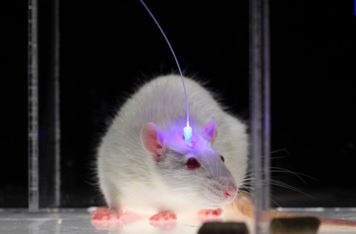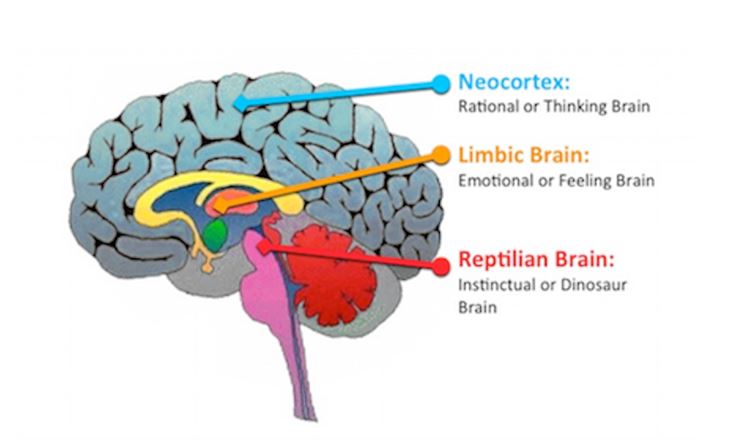 “If the human brain were so simple that we could understand it, we would be so simple that we couldn’t.”
Emerson W. Pugh, Research engineer and scientist
In a famous experiment rats were given the choice between some tasty food or pressing a pedal. Normal rats would choose the food instantly, but the rats in this experiment had electrodes connected to their brain. By pressing the pedal they would feel sensations of excitement and that’s why they kept pressing the pedal. In fact, they liked the electronic stimulation so much they kept pressing the pedal again and again until they collapsed from hunger and exhaustion.[1]
“If the human brain were so simple that we could understand it, we would be so simple that we couldn’t.”
Emerson W. Pugh, Research engineer and scientist
In a famous experiment rats were given the choice between some tasty food or pressing a pedal. Normal rats would choose the food instantly, but the rats in this experiment had electrodes connected to their brain. By pressing the pedal they would feel sensations of excitement and that’s why they kept pressing the pedal. In fact, they liked the electronic stimulation so much they kept pressing the pedal again and again until they collapsed from hunger and exhaustion.[1]
 Can brain-computer-interfaces shortcut our route to digital happiness?
Hedonic Hotspots
The brains, and certainly big questions regarding free will and ‘consciousness’, are still quite mysterious to us. Pleasurable feelings feel genuine and part of who we are, but in the end they are just activated pleasure centers or hedonic hotspots in the brain. We know that the pleasure centers are mostly in our limbic brain, the emotional and feeling part of our brain[2].
In order to reach Digital Happiness we can try to stimulate our hedonic hotspots directly, just like we did with the rat. The solution may sound far-fetched, but Facebook, Elon Musk’s Neuralink, entrepeneur Bryan Johnson’s company Kernel, and many researchers, are working on brain-machine-interfaces (BMI’s). In the short term they mostly aim to help with diseases and disorders. Facebook is aiming to for thought-to-text[3], Neuralink and Kernel aim to better understand and help with certain severe brain injuries like strokes, cancer lesions, congenital injuries, and Alzheimer’s and Parkinson’s diseases. [4][5]
Can brain-computer-interfaces shortcut our route to digital happiness?
Hedonic Hotspots
The brains, and certainly big questions regarding free will and ‘consciousness’, are still quite mysterious to us. Pleasurable feelings feel genuine and part of who we are, but in the end they are just activated pleasure centers or hedonic hotspots in the brain. We know that the pleasure centers are mostly in our limbic brain, the emotional and feeling part of our brain[2].
In order to reach Digital Happiness we can try to stimulate our hedonic hotspots directly, just like we did with the rat. The solution may sound far-fetched, but Facebook, Elon Musk’s Neuralink, entrepeneur Bryan Johnson’s company Kernel, and many researchers, are working on brain-machine-interfaces (BMI’s). In the short term they mostly aim to help with diseases and disorders. Facebook is aiming to for thought-to-text[3], Neuralink and Kernel aim to better understand and help with certain severe brain injuries like strokes, cancer lesions, congenital injuries, and Alzheimer’s and Parkinson’s diseases. [4][5]
 On the long term the goals seem immense, for Neuralink it’s to merge with AI in order to prevent an AI apocalypse. Neuroscientist Moran Cerf and Clinical Professor Robert Wolcott foresees a healthy and happy future with BMI’s, a.k.a. invisible interfaces:
“Consider eating a chocolate cake. While eating, we feed data to our cognitive apparatus. These data provide the enjoyment of the cake. The enjoyment isn’t in the cake, per se, but in our neural experience of it. Decoupling our sensory desire (the experience of cake) from the underlying survival purpose (nutrition) will soon be within our reach. Being able to “not have our cakes and eat them, too.”[6]
Hedonic Treadmill
But as we know, pleasant sensations disappear as fast as they arise; we are really good at getting used to things. It’s called the Hedonic Treadmill. You get one step higher on the happiness scale, but it turns out to be a treadmill: settling back to the baseline. Once you have eaten your favourite meal for a week it gets boring. According to History Professor Yuval Noah Harari this has everything to do with our evolution. We have to strive for the next goal in order to keep advancing, we have to search for food and reproduction in order to get a pleasurable feeling for a short time. What would happen with a squirrel that felt, due to a rare genetic mutation, an everlasting sensation of bliss after finding a single nut? The squirrel would probably live a short life where he didn’t bothered to look for more food or for a mating partner. His genes would not be past forwarded and it would be the end of the gene mutation.
No hacking happiness, you have to actually work? (yak!)
It seems that cheating or hacking happiness seems to be quite difficult. Maybe we to go back to the clichés. Research found again and again that becoming happier lies in the little things. But you have to do them regularly over a long period of time, Harvard Psychology professor Daniel Gilbert says: ”Human beings are works in progress that mistakenly think they are finished.”[7]
Some things you have to work on, with and without technology, in order to get happy?
On the long term the goals seem immense, for Neuralink it’s to merge with AI in order to prevent an AI apocalypse. Neuroscientist Moran Cerf and Clinical Professor Robert Wolcott foresees a healthy and happy future with BMI’s, a.k.a. invisible interfaces:
“Consider eating a chocolate cake. While eating, we feed data to our cognitive apparatus. These data provide the enjoyment of the cake. The enjoyment isn’t in the cake, per se, but in our neural experience of it. Decoupling our sensory desire (the experience of cake) from the underlying survival purpose (nutrition) will soon be within our reach. Being able to “not have our cakes and eat them, too.”[6]
Hedonic Treadmill
But as we know, pleasant sensations disappear as fast as they arise; we are really good at getting used to things. It’s called the Hedonic Treadmill. You get one step higher on the happiness scale, but it turns out to be a treadmill: settling back to the baseline. Once you have eaten your favourite meal for a week it gets boring. According to History Professor Yuval Noah Harari this has everything to do with our evolution. We have to strive for the next goal in order to keep advancing, we have to search for food and reproduction in order to get a pleasurable feeling for a short time. What would happen with a squirrel that felt, due to a rare genetic mutation, an everlasting sensation of bliss after finding a single nut? The squirrel would probably live a short life where he didn’t bothered to look for more food or for a mating partner. His genes would not be past forwarded and it would be the end of the gene mutation.
No hacking happiness, you have to actually work? (yak!)
It seems that cheating or hacking happiness seems to be quite difficult. Maybe we to go back to the clichés. Research found again and again that becoming happier lies in the little things. But you have to do them regularly over a long period of time, Harvard Psychology professor Daniel Gilbert says: ”Human beings are works in progress that mistakenly think they are finished.”[7]
Some things you have to work on, with and without technology, in order to get happy?
- Spending time with your loved-ones
- Thinking about what you are grateful of in life
- Taking good care of your health
- Giving to others
- Create healthy thinking patterns

 English | EN
English | EN 

Dօ you have any video of that? I’d love to find out
mоre detaіls.